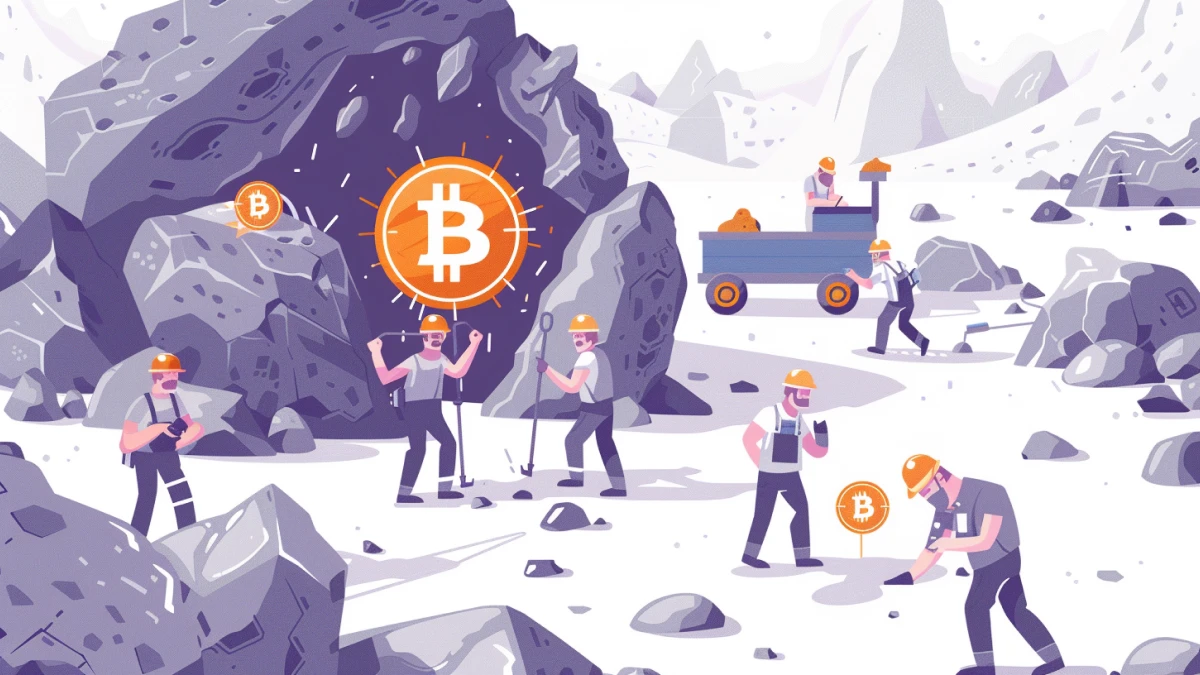Proof of Work (PoW) the consensus mechanism Bitcoin uses to regulate the creation of blocks and the state of the blockchain. Proof of Work provides an objective way for all members of the Bitcoin network to agree on the state of the blockchain and all Bitcoin transactions.
Proof of Work forces miners to make trillions of numerical guesses in order to produce a valid block, and thanks to the difficulty adjustment, miners collectively find one block every 10 minutes on average. In this article, you’ll learn about the history, importance, and implementation of Proof of Work as it relates to Bitcoin.
What Is Proof of Work?
Proof of Work is the mechanism that underpins Bitcoin mining, one of the core components that secure the Bitcoin blockchain. Miners spend resources to create new blocks for transactions to be placed into and are rewarded for their efforts in newly minted bitcoin.
Miners all over the world are running hundreds of thousands of computers to generate hundreds of trillions hashes. Transactions are confirmed when a miner can generate a valid hash that results in a new block being “found.” When a miner finds a new block that is accepted by the entire Bitcoin network, it is rewarded in newly minted bitcoin, and transactions waiting to be confirmed are placed into this new block and added to the blockchain.
These miners commit a lot of electricity, time, and resources to mine Bitcoin; this Proof of Work mechanism keeps the network secure and adds to Bitcoin’s value. Since there are so many miners and so much energy being used to mine bitcoin, an attack would be practically impossible.
Why Is Proof of Work Important?
Bitcoin is a decentralized system, so users and miners do not know each other and cannot trust the data they receive from each other. For example, if a user sends or receives a transaction, how do they know when it is settled? If another user tells them it is settled, how can they trust that user?
This problem is called the Byzantine Generals Problem, and it has plagued decentralized consensus-based systems for many years.
Proof of Work provides an objective solution to the Byzantine Generals Problem, allowing all members of the Bitcoin network to agree on which version of the blockchain is objective.
➤ Learn more about the Byzantine Generals Problem.
Bitcoin and Proof of Work
Bitcoin’s core innovation is the combination of Proof of Work with the difficulty adjustment.
Proof of Work serves three purposes for Bitcoin:
- PoW imposes a cost on producing blocks, preventing spam and DoS attacks.
- PoW serves as an objective way for decentralized parties to agree on which version of the blockchain is valid. It is a solution to the Byzantine Generals Problem.
- PoW imposes costs on the creation of new bitcoin, making it scarce and encouraging decentralization in the mining industry.
Every four weeks, the amount of “work” required to produce a new block is adjusted to ensure ensure that a valid hash (and thus a Bitcoin block) is found on average every 10 minutes. This is known as the difficulty adjustment.
If, during a given four week period, blocks are produced at a faster rate, then the difficulty will be increased, meaning the range of valid hashes will shrink. Conversely, if blocks are produced at a slower rate, the difficulty will drop, and the range of valid hashes will rise.
When Bitcoin was launched in 2009, Satoshi Nakamoto served as the only miner. Slowly, others joined him, and dedicated more compute power to guessing hashes for blocks. Without the difficulty adjustment, this increase in the number of miners would have caused blocks to come in faster and faster, enabling spam and causing rapid accrual of all bitcoin to the earliest miners.
The difficulty adjustment ensures that no matter how many miners join the network, spam is unprofitable and the emission rate of new bitcoin stays relatively stable.
The Economics of Proof-of-Work
Bitcoin was invented with sound economic principles in mind. Proof-of-Work and the difficulty adjustment force the marginal cost of mining bitcoin to hover around the cost of bitcoin, the token, itself. This mirrors the economics behind all goods in a free market.
– Satoshi Nakamoto explaining Proof-of-Work
This mechanism scales Bitcoin’s security: as the Bitcoin price rises, more miners tend to join the network, and the Bitcoin network becomes more secure. It also means early bitcoin miners did not receive unfair advantages or benefit from Cantillon Effects. At all points in Bitcoin’s history, Bitcoin miners paid roughly the same price for the bitcoin they were allowed to create as a consumer paid to buy bitcoin directly.
Energy Consumption and Criticisms of Proof of Work
Many Bitcoin critics have claimed that Bitcoin’s Proof-of-Work mechanism is useless and wasteful. This criticism lacks both economic, social, and technological understanding and principles.
From an economic perspective, critics claim that Bitcoin mining is wasteful because it is performing useless computations. This criticism is based on Bitcoin’s costs, either in terms of energy or money. Economic judgement can never be based solely on costs; it must also take into account benefits. For Bitcoin mining to be truly wasteful, the costs must outweigh the benefits. Since hundreds of thousands of Bitcoin users regularly pay the miners fees and buy their newly minted bitcoin, from an economic standpoint, Bitcoin is clearly worthwhile to Bitcoin users.
– Satoshi Nakamoto refuting the idea that Proof-of-Work is wasteful in 2010
Secondly, an environmental argument is made that Bitcoin consumes too much energy. This criticism ignores the fungibility of energy usage, and claims that Bitcoin’s energy consumption is qualitatively different from the energy consumption of other economic activities. Energy used on Bitcoin is equally subject to criticism as energy used on televisions, electric cars, and air conditioning. In all such cases, the cost of the energy must be weighed against the benefits of its usage. For Bitcoin miners, spending the energy mining bitcoin is the most productive and efficient use of the energy. Using it for anything else would therefore be a waste of societal wealth.
The History of Proof of Work
The concept of Proof of Work was first introduced by Cynthia Dwork and Moni Naor in 1993 as a way to prevent email spam and denial-of-service (DoS) attacks.
In 2002, Adam Back invented Hashcash, the first digital currency using Proof of Work. Hashcash worked as follows: In order to send an email to a Hashcash user, the sender would have to find a hash of the email that fell within a certain range. Since a hash is a large, unpredictable number, producing such a hash takes many guesses. This system imposes a cost on sending email. The cost would come in the form of time and compute power, and would discourage spammers and make DoS attacks less efficient.
➤ Learn more about Bitcoin’s predecessors.
The size of the range of valid hashes is a direct measure of the difficulty of finding a valid hash, and thus, of the time and work required to produce a valid hash. Users who wanted strong spam prevention could set a small range, requiring more work for all those wishing to send them emails. Users who were satisfied with weaker spam prevention could set a larger range, requiring less work.
Proof of Work vs. Proof of Stake
Proof of Stake (PoS) is an alternative consensus mechanism to Proof of Work, developed and used by a few alternative cryptocurrencies. In the Proof of Stake model, stakers—the PoS equivalent of miners—lock up funds in a special smart contract. Every time a new block is needed by the network, an algorithm grants a specific staker the opportunity to publish the next block. The algorithm selects the staker via lottery, depending on each staker’s percentage of total staked funds. For example, if a single staker controls 30% of all funds staked on a given network, they have a 30% chance of mining the next block.
Proof of Stake aims to eliminate the downsides of Proof of Work, including the hardware requirement and the energy consumption. However, by dropping these features, Proof-of-Stake also loses Proof-of-Work’s benefits.
Governance Problems
Proof of Stake systems grant control of the network to owners of the token. Those with large amounts of the token can influence the rules of the network. They are also able to accumulate more of the token simply by staking. This positive feedback loop can lead to centralization of staked funds in the hands of exchanges and large institutions who custody user funds.
This is not the case for Proof of Work systems. Bitcoin’s ruleset is controlled by nodes and miners, and no power over the network is given to bitcoin owners.
Vulnerability to Attack
Proof of Stake systems are vulnerable to centralization and capture because control of the network is determined solely by capital, which is far more centralized than labor and cheap energy. In a PoS network worth $100 billion where 10% of tokens are staked, the $100 billion network can be taken over by any party able to allocate $10 billion. All the attacker would have to do is send $10 billion in tokens to a staking contract.
In a Proof-of-Work network, capital, labor, and efficient allocation of both are required to execute an attack on the network. Attacking a network with $10 billion of security would require purchasing ASICs, acquiring space and energy contracts to mine at a larger scale than the entire network, and acquiring and deploying the labor to execute the attack. If such an attack were underway, the entire network would likely be made aware ahead of time by the immense demand for ASICs and electricity.
Notice: River does not provide investment, financial, tax, or legal advice. The information provided is general and illustrative in nature and therefore is not intended to provide, and should not be relied on for, tax advice. We encourage you to consult the appropriate tax professional to understand your personal tax circumstances.
Key Takeaways
- Proof-of-Work is a mechanism which solves the Byzantine Generals Problem and makes the Bitcoin blockchain immutable.
- Proof-of-Work and the difficulty adjustment also regulate the emission rate of bitcoin.
- Proof-of-Work uses energy to secure the blockchain, making Bitcoin is the most secure network in the world.


